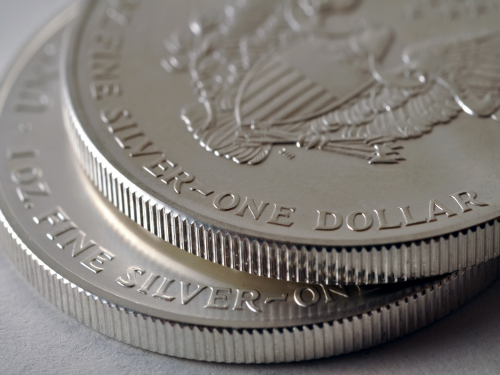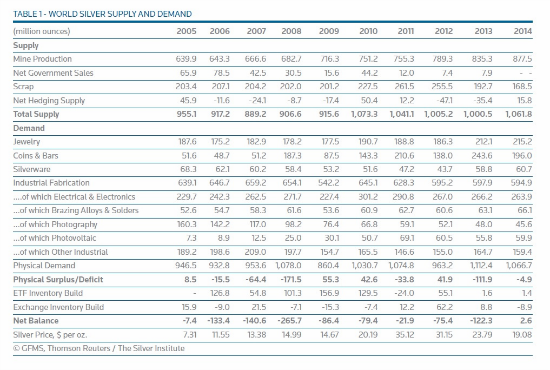
According to most precious metal investors, a day of reckoning is rapidly approaching for the silver market. The numbers just don’t seem to add up. Government mints all across the planet are running low on silver as investors snap up as many coins as they can. The US Mint alone managed to sell nearly 15 million ounces of silver last quarter, which is the most they’ve ever sold since they started keeping track in 1986. At one point they even had to ration their Silver Eagles.
Meanwhile, the price of silver is still hovering at around $16 per ounce. At first glance it doesn’t really make sense. There seems to be plenty of demand, supply is looking low, and yet the price hasn’t really changed a whole lot. What gives?
There are of course plenty of theories that suggest the precious metal markets are being manipulated. There’s also plenty of evidence to back up those theories. At the end of the day though, we’re still dealing with a real product that is bound by the laws of the marketplace. These shenanigans can only effect the price to a certain degree, and I think there are several clearly visible factors that are also working to keep the price of silver down, at least for now.
The issue that many silver investors tend to overlook, is that coin and bullion sales only make up a small (but significant) part of the total consumption of silver. While the rapid depletion of Silver Eagles is certainly indicative of a high demand, it doesn’t give us the whole picture (and as you’ll soon see, global silver supply isn’t actually low at the moment. It’s only diminishing for government mints). For that, we need to see how much physical silver is introduced to the marketplace, and consumed by different industries.
Fortunately, the Silver Institute has been gathering statistics on global silver production and consumption for nearly ten years now, and their numbers give us a fairly good idea of what’s driving prices.

The biggest factor that’s influencing silver prices right now, is probably the first item on this list, which is mine production. As you can see, the production of silver has gone up consistently, year after year, even as demand grew softly and prices plummeted. In all likelihood, that’s because most significant developments in the mining sector occur when profits are increasing.
It often takes several years for a mine to enter full production, and there are countless silver mines all over the world that were built when silver was above $30 an ounce. Unfortunately, many of these mines are no longer profitable at current prices. So what you’re seeing is an industry that is often a few years behind the trend, and is now producing more supply than the global marketplace is asking for.
For now that’s probably driving the price down, but eventually some of these mines are going to close. They’re simply not profitable. When that happens, the lowered supply is going to lift the weight off current prices.
Meanwhile, government sales of old stockpiles are essentially nonexistent, and have little if any bearing on prices these days. They used to be a major driving force in the world’s annual silver supply, but these stockpiles are a shadow of their former selves. What’s left, is being closely held by the world’s governments.
As for the demand side of things, we have a few interesting takeaways. The sale of coins, bars, and jewelry are definitely having some effect. Jewelry has gone up modestly over the past decade, while coins and bullion have exploded. They slumped a little last year, but given some of the shortages we’ve seen this year, it will probably make a big turnaround when the data for 2015 arrives.
When you see that global annual demand increased by 120 million ounces in 9 years, while demand for jewelry, coins, and bars increased by 172 million ounces over the same period, it’s clear that investment and jewelry purchases are the only thing keeping the price afloat in spite of prolific mine production.
Another interesting fact is that industrial demand isn’t driving the price as much as you might think. Overall, it’s actually gone down slightly. Most industries seem to be holding steady or increasing though. Solar panels are responsible for the most gains, which will likely pick up in the years ahead. And despite the proliferation of electronics, that industry’s silver consumption has only seen a modest increase. That’s because the electronics industry is always working to make their manufacturing more cost effective. Even as computing power increases, the amount of precious metals in each device has been decreasing.
However, there is one factor that’s keeping overall industrial demand down, and that is photography. Predictably, the photography industry has been consuming far less silver (most notably for silver nitrate film) as the electronics industry has increased consumption (for digital cameras and other devices). Eventually, there will be almost no silver demand from the film industry, while other industries will continue to gobble up more precious metals. If current trends hold, then overall industrial demand will start to lift in a big way once the photography trend bottoms out.
So to recap, there are three major influences on the price of physical silver, and they all seem to point towards a future with higher prices. Jewelry, coins and bullion sales are increasing at a hefty pace, and are probably the only products holding prices up while the mining sector oversaturates the marketplace. The decline of analog photography is holding back industrial demand, and once it goes the way of the dodo, electronics and solar panels are going to pave the way for more consumption. And when all those unprofitable mines go belly up, we may finally see a big crunch in silver supplies, and a corresponding increase in prices.
So in short, get it while the getting is good.

the thing that keeps the price of silver and gold down is PAPER TRADING People are selling metals contracts for hundreds of ounces of metal that are backed by only one or two ounces of actual physical metal. With COMPUTER GENERATED TRADING the price can be manipulated any way the computer wants it to go. At some point though investors will want the actual physical metal-and , when there is none-then you will see the price of these metals take off.
Never buy silver or gold when you are given PAPER!…
For goodness sakes… we are talking money here, when did real people ever get so brainwashed that they pay out hard earned money and accept paper and the promise of a stranger?
Are we mad?
I have always found it interesting that many articles of this type do not have a publishing date with them. For all we know, this could have been written years ago by a perpetual doom and gloomer!